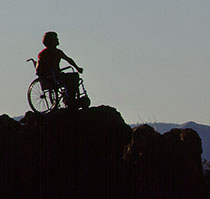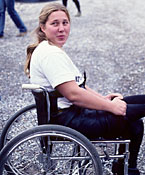SAMPLE PARTICIPATION SPREAD SHEET
|
Activity Breakdowns
At the end of the year, add up the total participants, participant-hours and participant-days for each activity offered by the program. It is helpful to break down the activity categories into a system similar to the categories shown in the tables at the end of this paper. This division between activities makes a cost benefit analysis easier to conduct as well as providing program managers with a more complete information on what aspects of the program are most popular.
Without collecting any additional data, several pieces of information are now available, including the number of trips and events offered in each activity category, the amount of time involved by participants in each activity and the total number of activities offered. Determining Benefits
Program benefits are based on the value of services provided. In an disabled recreation program, the value of a particular service is the amount of money that an individual is willing to pay for a comparable commercial service. The tables at the end of this paper lists the values of indoor and outdoor recreational activities utilized by disabled programs. It was prepared by averaging the prices of a national sample of athletic clubs, ski schools and other commercial recreation service providers.
Note that the activities are grouped according to whether they take place on an hourly, a day or multi-day basis. This breakdown was determined largely by how the activity is commonly packaged in the market place. For instance, rafting excursions are typically one day or multi-day affairs. Few rafting trips go for less than a day since getting to river, blowing up boats, running the river, having lunch, and deflating boats and packing boats normally takes a day to undertake. Because of this, you'll notice that the "Table of Values" does not include an hourly value for rafting.
You may find that the table does not list all the activities offered by your program. It does, however, include an average value for indoor activities and outdoor activities (by hour, day or multi-day). For any activity which you offer but not included on the table, use the average value. For instance, if you offer one hour of bowling, use the average indoor activity of $9.66 per hour.
With this information and with figures from the Activity Catering Spread Sheet, the dollar amount of benefits for each category can be calculated: Benefits of Activity = Value of Activity x # of Part.-days For example, lets say you have 10 participant-days of canoeing for the year: Benefits = $94.90 per part.-day x 10 part.-days = $949.00 In addition, you can factor in other benefits. Disabled programs spend a considerable amount of time fund raising. Total income derived from fund raising is a benefit of the program and, if desired, can be added to the benefit figure. Additionally, disabled programs typically utilized volunteers. During the course of the year, record the number of volunteer hours on the master data sheet. At the end of the year, tally up the total number of volunteers hours and multiple it times the minimum wage. This will give you the value of services provided by volunteers. The sum of all these figures equals the total benefits of the program.
Cost Benefit Calculation
The last part of the cost benefit analysis is the cost of the program. That's easy. The cost is the total operating budget of the program.
With the total figures the benefit/cost (B/C) ratio can be calculated: B/C Ratio = Total Benefits Total Costs As an example, let's say the total benefits of the program are $l00,000 and the total operating cost is $98,000. The benefit/cost ratio is: $l00,000/$98,000 = 1.02
Value of a Cost Benefit Analysis
What the benefit/cost ratio indicates is the amount of return per dollar of operating expense. In the above example, every dollar invested by the program returns $1.02 in benefits. The Corps of Engineers uses a benefit/cost analysis in determining the value of public works projects. If the B/C ratio is over 1.0, the project is considered prudent use of public funds.
Many programs may not achieve a 1.0 or greater benefit/cost ratio. That's understandable, since a recreation program is far more labor intensive when compared to comparable commercial services. Done from year to year, however, the benefits/cost ratio does provide objective data on fiscal efficiency. If the ratio takes a sudden drop, it might indicate problem with the program's finances and a more thorough budget evaluation would be in order.
When used by itself, the benefits figure can be valuable in justifying the program to potential donors or granting sources. Describing the benefits in terms of dollar amounts provides a new way for people view disabled recreation. In particular, business and industrial philanthropical interests are absorbed in world defined in terms of dollars and readily relate to such figures. At the very least, it's another piece of data that helps build your credibility. To say that your program generates $75,000 in recreational benefits to disable participants or that volunteers provide $15,000 worth of time to your program helps paint an understandable picture of an worthwhile endeavor.
Computerizing Records
Much of the routine work can be taken out of keeping records by using a computer. For the type of participant record keeping described in this chapter, a spread sheet software program, such as Lotus, Excel or others are extremely useful.
With such programs a master data sheet can be designed using the same format as shown in the sample spread sheets described earlier in the chapter. Include on the spread sheet columns for numbers of disabled participants, able-bodied supporters who attend fun raiser or participate in trips and volunteers who help in with the program.
On the last column of the sheet, include a code that identifies the activity type A sample code might be RF2 (used in an example above) which stands for rafting, multi-day trips. Make the codes compatable with the activity categories listed the Table of Values. With this information, all the entries on the master data sheet can easily be sorted by the computer software into code categories, and you'll be ready to calculate the benefits/cost ratio without resorting to adding a lot of columns with a calculator. TABLES: Values of Recreational Activities Based on surveys conducted by R. Watters from 1989 through 1991. Numbers represent the average market price of commercially available recreational activities. Final values were derived by eliminating the high and low market values and averaging the rest. Table 1: Indoor Recreational Activities
Table 2: Outdoor Recreational Activities lasting in excess of one day.
Table 3: Outdoor Recreational Activities lasting
Table 4: Outdoor Recreational Activities lasting less than 8 hours.
Links to Other Outdoor Education Papers
|


